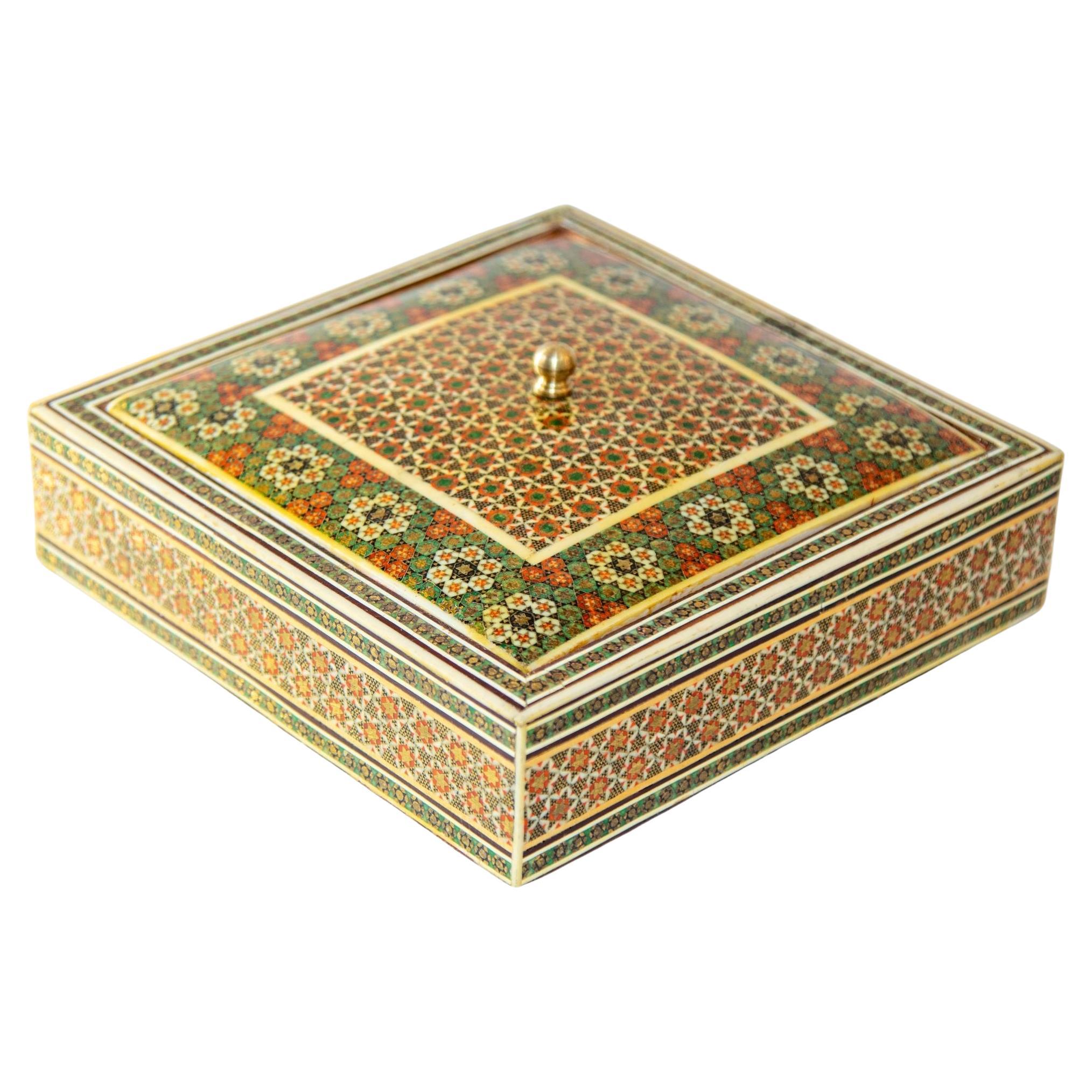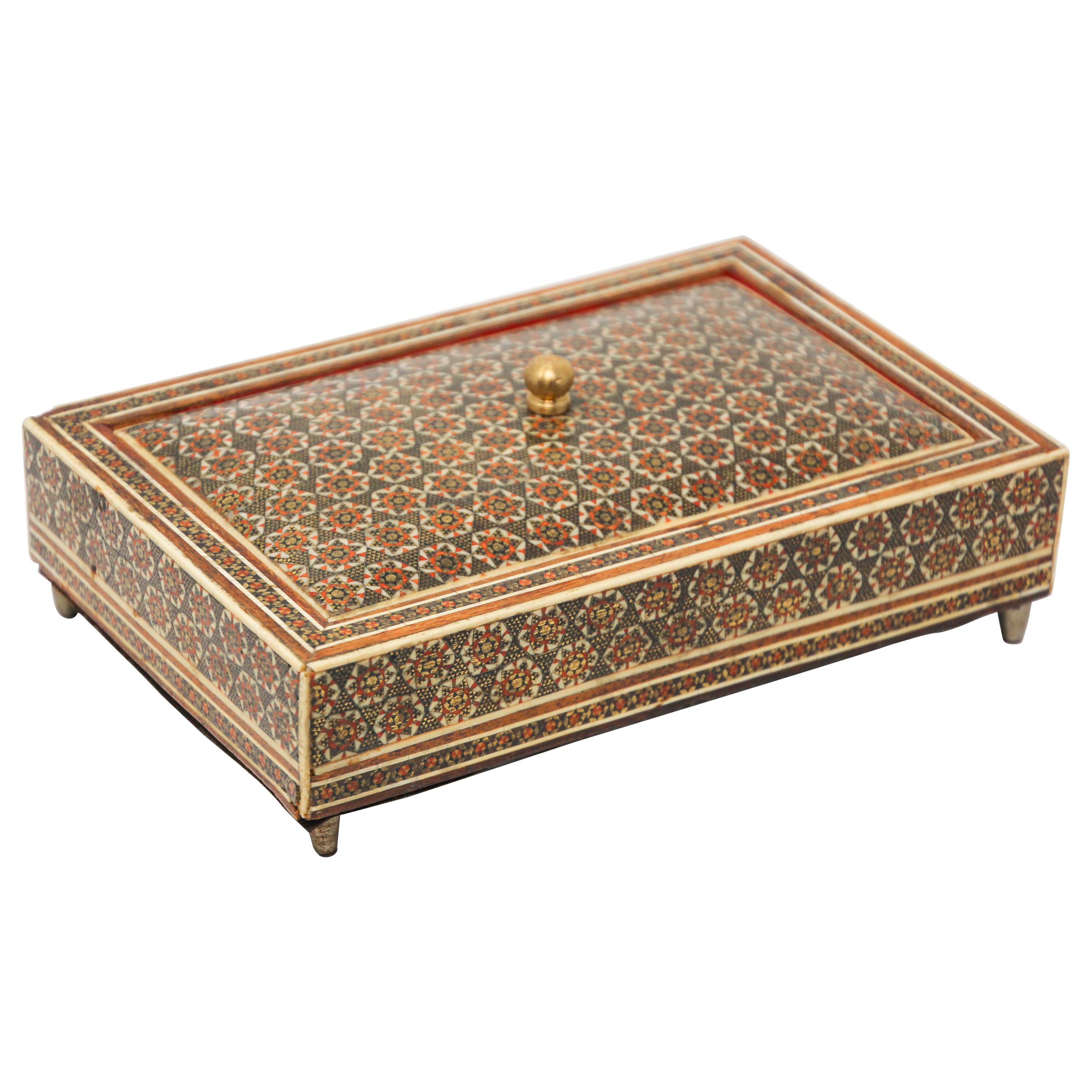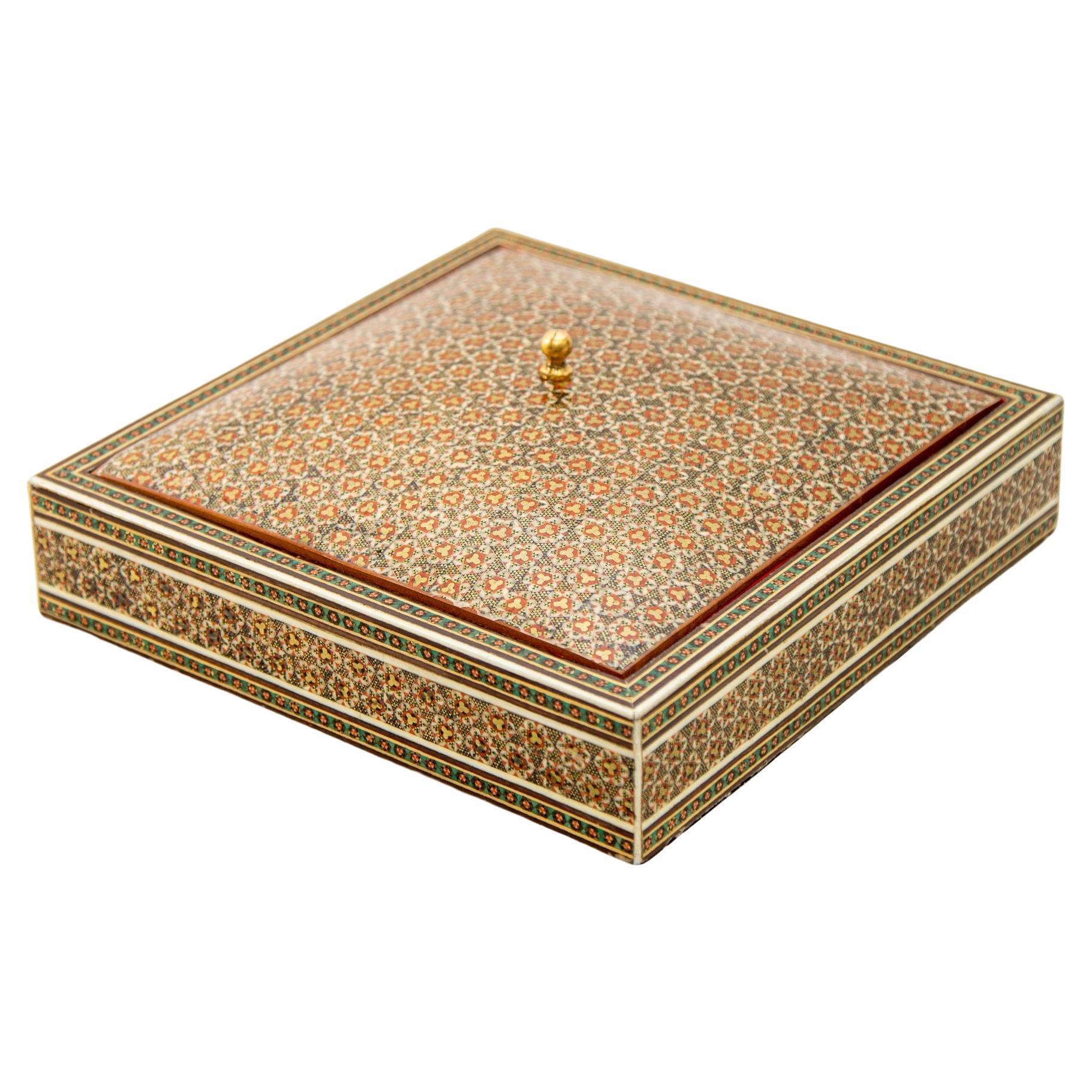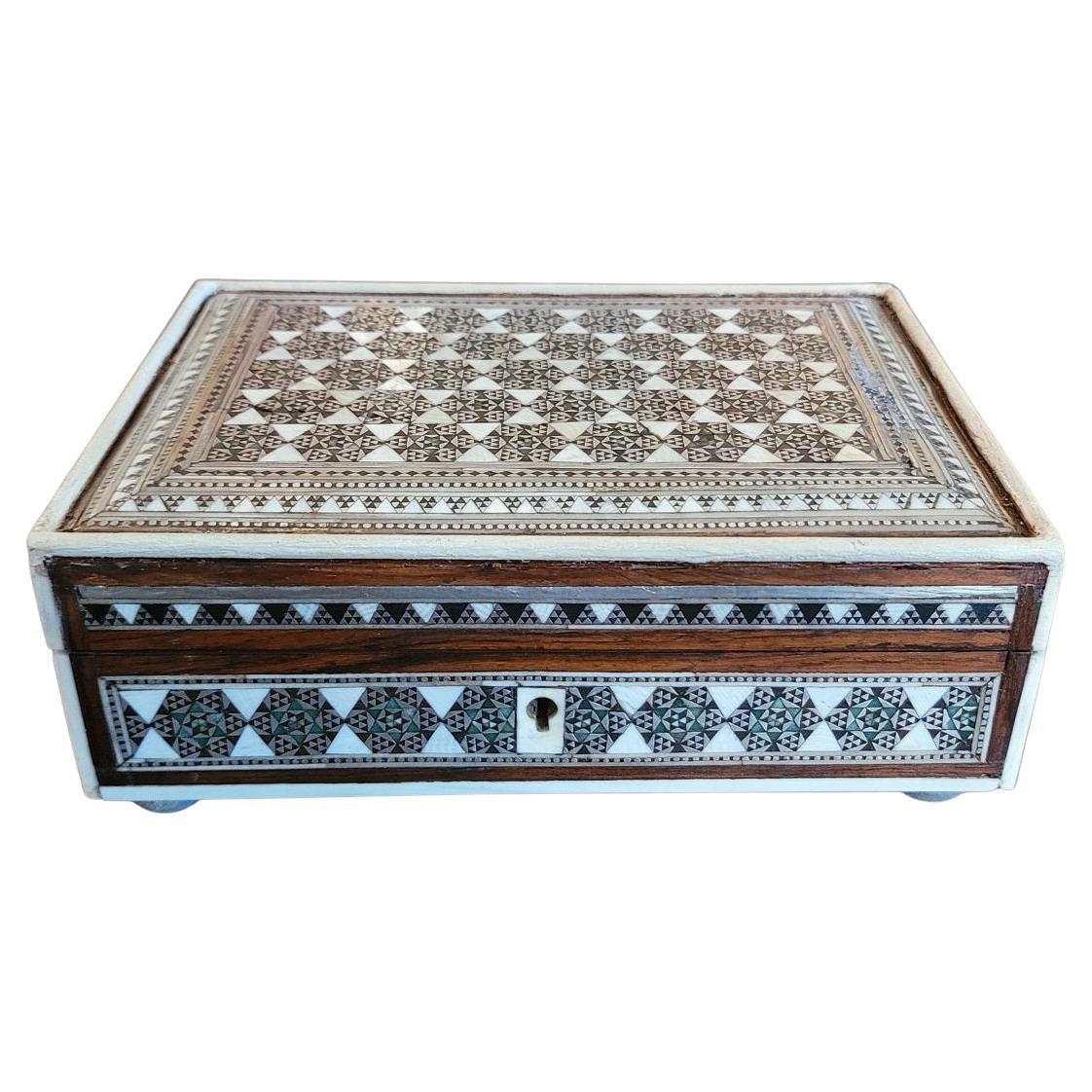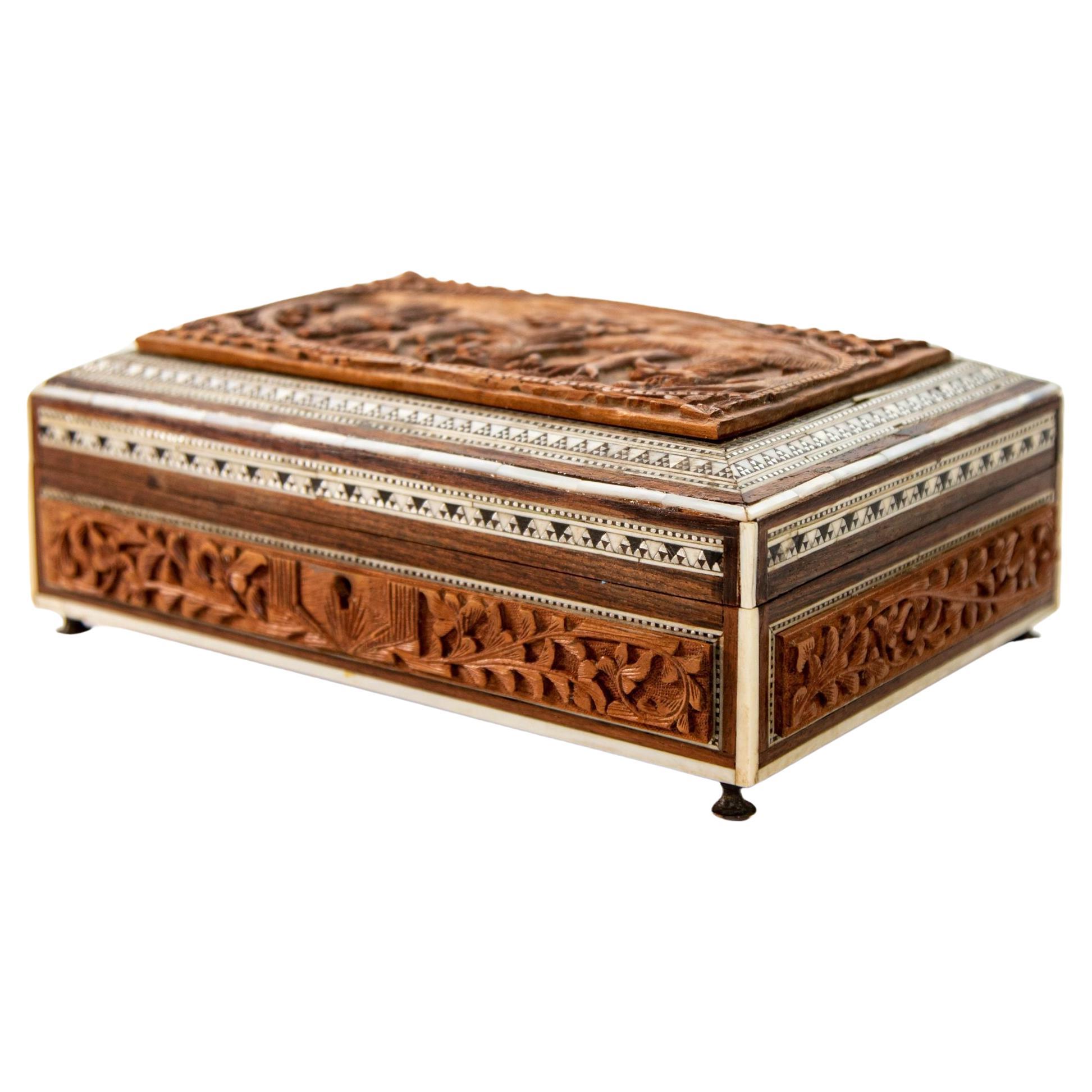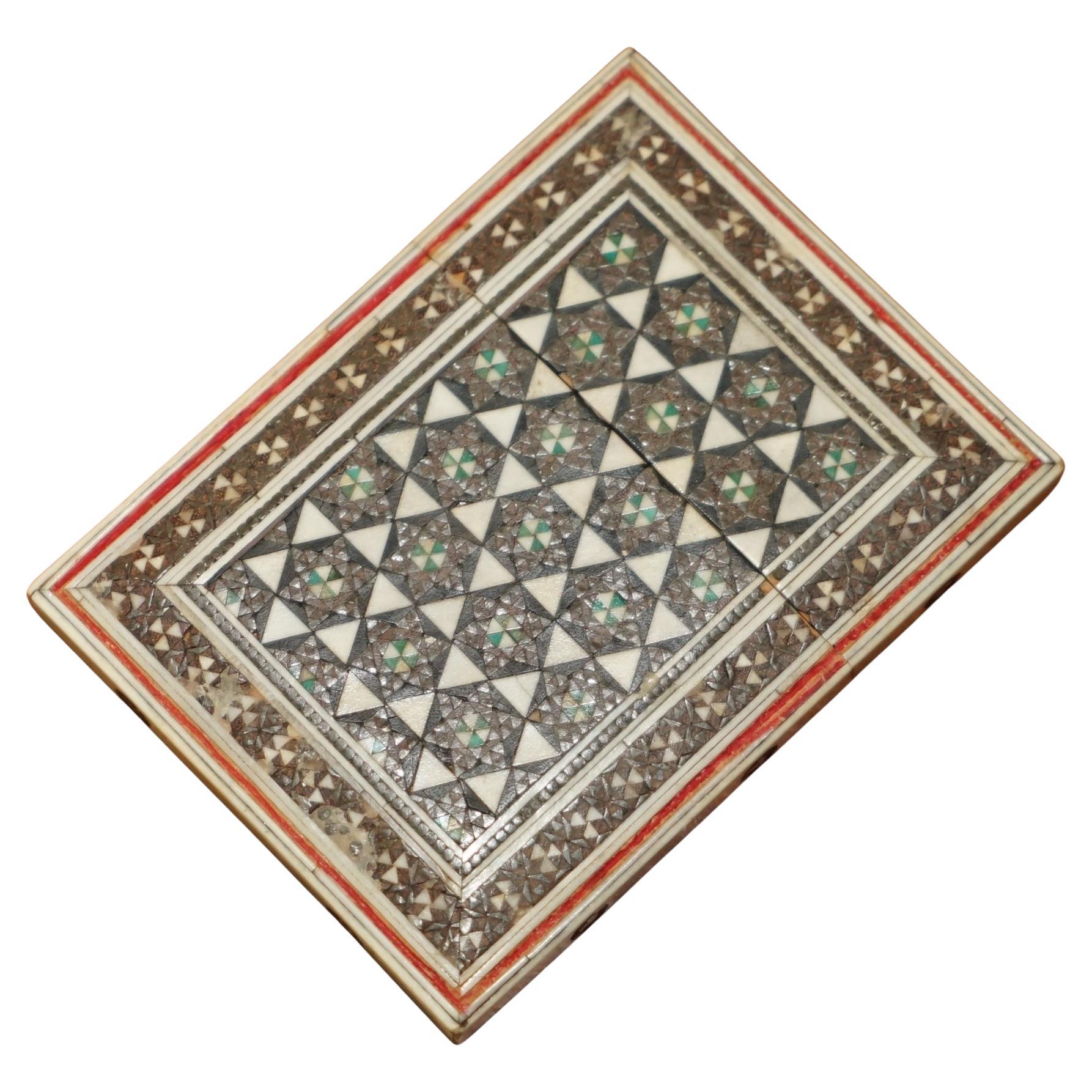Items Similar to Anglo Indian Micro Sadeli Mosaic Inlaid Hexagonal Box
Want more images or videos?
Request additional images or videos from the seller
1 of 14
Anglo Indian Micro Sadeli Mosaic Inlaid Hexagonal Box
About the Item
Anglo Indian Moorish style micro mosaic inlaid jewelry box with lid.
Intricate inlaid Anglo Indian box with floral and geometric Moorish Sadeli design in an octagonal shape form with micro mosaic marquetry, very fine artwork.
Museum collector piece like the one in Doris Duke Islamic Art Museum.
The repeating geometric patterns of Sadeli Mosaic are what give it beauty and richness. This decorative technique is a type of micro mosaic featuring repeating geometric patterns.
Dimensions: Height: 5 in (12.7 cm)Diameter: 8.5 in (21.59 cm)
A highly skilled craft, it has had a long history in India and the Middle East with early examples dating back to the 16th century. In the 1800s, it became popular as a decoration on a variety of boxes, card cases, and chess boards imported from India. Since Bombay became a center of making them, they became known as Bombay boxes.
The ancient art of Sadeli Mosaic is said to have been introduced from Shiraz in Persia via Sind to Bombay, a long time before Indian boxes appeared. The designs on early boxes look deceptively simple. The fact is they emerged from a culture which had mastered geometry and understood how to generate a pattern from a set number of points. The patterns are so harmoniously combined that their incredible complexity isn’t immediately apparent to the viewer.
- Dimensions:Height: 5 in (12.7 cm)Diameter: 8.5 in (21.59 cm)
- Style:Moorish (In the Style Of)
- Materials and Techniques:
- Period:
- Date of Manufacture:1920
- Condition:Good Wear consistent with age and use.
- Seller Location:North Hollywood, CA
- Reference Number:
About the Seller
5.0
Platinum Seller
These expertly vetted sellers are 1stDibs' most experienced sellers and are rated highest by our customers.
1stDibs seller since 2011
2,631 sales on 1stDibs
Typical response time: 1 hour
- ShippingRetrieving quote...Ships From: North Hollywood, CA
- Return PolicyA return for this item may be initiated within 7 days of delivery.
More From This SellerView All
- 1950s Anglo Indian Micro Sadeli Mosaic Inlaid Jewelry BoxLocated in North Hollywood, CA1950s Anglo Indian Micro Sadeli Mosaic Inlaid Jewelry Box. DIMENSIONS: 7ʺW × 7ʺD × 2.5ʺH. Indo Persian Moorish style micro mosaic inlaid jewelry box with lid. Intricate inlaid Anglo ...Category
Mid-20th Century Indian Moorish Decorative Boxes
MaterialsFruitwood, Bone
- Moorish Decorative Sadeli Micro Mosaic Inlaid Jewelry BoxLocated in North Hollywood, CAMiddle Eastern Sadeli micro mosaic inlaid jewelry footed box with lid. Intricate inlaid box with floral and geometric Moorish design. Sadeli micro mosaic designs in mosaic marquetry, very fine artwork. Lined with red velvet and glass, top final and feet are brass. A highly collectible example in superb condition complete Circa 1900. Museum piece like the ones in Doris Duke Islamic Art Museum. Middle Eastern Arabian Micro Mosaic Moorish...Category
Early 20th Century Lebanese Moorish Decorative Boxes
MaterialsFruitwood
- 1950s Anglo Indian Style Micro Mosaic Inlaid Jewelry BoxLocated in North Hollywood, CA1950's Anglo Indian, Indo Persian style micro mosaic inlaid jewelry box with lid. Large vintage intricate inlaid middle Eastern Persian style box with floral and geometric Islamic Mo...Category
Mid-20th Century Indian Anglo-Indian Decorative Boxes
MaterialsFruitwood
- Antique Anglo-Indian Vizagapatam Jewelry Inlaid Sadeli Footed BoxLocated in North Hollywood, CAAntique 19th century Anglo-Indian jewelry, trinket footed box, inlay with ebony, mosaic marquetry Sadeli work and a carved Hindu scene on top. The box case is made from sandalwood wi...Category
Early 20th Century Indian Anglo-Indian Decorative Boxes
MaterialsWood, Bone, Mother-of-Pearl
- Large Antique Moorish Micro Mosaic Inlaid Jewelry Box Hexagonal ShapeLocated in North Hollywood, CALarge Middle Eastern Moorish style micro mosaic inlaid jewelry box with lid. Intricate hexagonal shape inlaid box with geometric Moorish design. I'm always astounded by the intricate...Category
Early 20th Century Lebanese Moorish Decorative Boxes
MaterialsFruitwood
- 19th Century Anglo-Indian Sadeli Mosaic Jewelry Box with Lidded CompartmentsLocated in North Hollywood, CA19th century Anglo-Indian sandal wood box, Sadeli mosaic box fitted with various compartments finely hand-carved with the Taj Mahal. Of sarcophagus form ...Category
Antique Late 19th Century Indian Anglo-Indian Decorative Boxes
MaterialsSandalwood
You May Also Like
- 19C Anglo Indian Bombay MOP Sadeli Mosaic Trinket BoxLocated in Dallas, TXPRESENTING a LOVELY 19C Anglo Indian Bombay MOP (Mother of Pearl) Sadeli Mosaic Trinket Box from circa 1875-85. Gorgeously detailed and hand-crafted ‘sadeli mosaic’ inlay, from the Bombay Area, with deep greens with silver, pewter, mother of pearl, bone and ebony in geometric patterns. The box case, is made of sandalwood but completely covered in MOP, bone, faux ivory, ebony and mosaic inlay. Edged with faux ivory and banded with a different pattern of sadeli mosaic. Some minor damage to the top (repair is obvious in pics) and ivorine replacements to some edging, but it still a BEAUTIFUL BOX and of real QUALITY! The mosaic work is FABULOUS! Box opens to reveal its original blue velvet lining. It sits on 4 (recently added) silvered button feet. SADELI MOSAIC: “Anglo Indian boxes were made in India for the English residents from the early part of the 18th century. They were brought back or sent back to England usually by the people who had commissioned them. From the beginning of the nineteenth century they were imported more commercially, although not in any significant numbers until the middle decades. They were very highly valued, especially the early ones, to the extent that the designs were copied on late 19th and early 20th century tins. The ancient art of Sadeli Mosaic is said to have been introduced from Shiraz in Persia via Sind to Bombay, a long time before the Anglo Indian boxes were made. It was a technique, which required a high degree of skill and patience. It was executed very lavishly, in that the frequent cuts wasted a great amount of the precious materials used. The workmanship was however more than commensurable to the value of the materials. Ivory, silver, pewter (or other metals), wood and horn were cut into faceted rods which were bound together to form geometric patterns. When the glue has set, the rods were sliced in transverse sections. This gave the maker a number of angled circular pieces in the original pattern. Several variations of patterns could be achieved by combining the materials in different ways. The ivory was sometimes dyed green to give an extra color. The mosaic pieces in a combination of patterns, often separated by ivory, ebony, horn or silver stringing were used to veneer sandalwood boxes. In the early boxes, which date from the turn of the 18th to the 19th century, there are large panels of mosaic covering tops and sides of boxes. It took incredible skill to cover such large areas without any shakes or wavering of the pattern. The corners and joins on these boxes are impeccably matched. The makers (reputed to be Persian) of Sadeli mosaic made in the first two decades of the 19th century displayed a total understanding of the qualities of the different materials they used. They combined substances, which can expand and contract according to atmospheric conditions with others, which are hard and unyielding. The result was a sharp definition of the lines and patterns, which made up the whole design. On the early boxes the designs look deceptively simple. The fact is, they emerged from a culture, which had mastered geometry and understood how to generate a pattern from a set number of points. The patterns are so harmoniously combined that their incredible complexity is not immediately apparent. The earliest Sadeli boxes...Category
Antique Late 19th Century Indian Anglo-Indian Jewelry Boxes
MaterialsSilver
- ORIGINAL ANTiQUE ANGLO INDIAN EXPORT SADELI MICRO MOSAIC BUSINESS CARD CASELocated in GBRoyal House Antiques Royal House Antiques is delighted to offer for sale this lovely, super decorative antique Islamic Anglo Indian Sadeli Micro Mosaic Card Case A wonderfully orig...Category
20th Century Indian Anglo-Indian Decorative Boxes
MaterialsWood
- Anglo Indian Micro Mosaic Inlay Jewelry BoxLocated in New York, NYExquisitely crafted early 20th century Anglo Indian micro mosaic Sadeli box with gorgeous antique Persian geometric pattern. The finely detailed box featu...Category
Early 20th Century Indian Anglo-Indian Jewelry Boxes
MaterialsFruitwood, Bone
- 19C Anglo Indian Carved Padouk Wood and Sadeli Mosaic BoxLocated in Dallas, TXPRESENTING A LOVELY 19th century Anglo-Indian Carved Padouk Wood and Sadeli Mosaic Box, featuring a carving of a Hunt Scene. Made circa 1870 in Bombay, India during the Rule of th...Category
Antique Late 19th Century Indian Anglo-Indian Jewelry Boxes
MaterialsSilver, Pewter
- 19C Anglo Indian Sadeli Mosaic Greeting Card CaseLocated in Dallas, TXPresenting a superb 19C Anglo Indian Sadeli Mosaic greeting card case. Made in or around Bombay, India circa 1880. This is a greeting card case used for holding your greeting cards or business cards of the day ! The body of the case is made from sandalwood and it is fully overlaid with bone and highly intricate Sadeli Mosaic made up of thousands of micro mosaic pieces of bone, ebony, silver/pewter and semi precious stone. The workmanship is stupenduous !!!! This case is almost museum quality. One or two very, very minor losses of mosaic mainly where the top meets the body but otherwise near mint ! SADELI MOSAIC: “Anglo Indian boxes were made in India for the English residents from the early part of the 18th century. They were brought back or sent back to England usually by the people who had commissioned them. From the beginning of the nineteenth century they were imported more commercially, although not in any significant numbers until the middle decades. They were very highly valued, especially the early ones, to the extent that the designs were copied on late 19th and early 20th century tins. The ancient art of Sadeli Mosaic is said to have been introduced from Shiraz in Persia via Sind to Bombay, a long time before the Anglo Indian boxes were made. It was a technique, which required a high degree of skill and patience. It was executed very lavishly, in that the frequent cuts wasted a great amount of the precious materials used. The workmanship was however more than commensurable to the value of the materials. Ivory, silver, pewter (or other metals), wood and horn were cut into faceted rods which were bound together to form geometric patterns. When the glue has set, the rods were sliced in transverse sections. This gave the maker a number of angled circular pieces in the original pattern. Several variations of patterns could be achieved by combining the materials in different ways. The ivory was sometimes dyed green to give an extra color. The mosaic pieces in a combination of patterns, often separated by ivory, ebony, horn or silver stringing were used to veneer sandalwood boxes. In the early boxes, which date from the turn of the 18th to the 19th century, there are large panels of mosaic covering tops and sides of boxes. It took incredible skill to cover such large areas without any shakes or wavering of the pattern. The corners and joins on these boxes are impeccably matched. The makers (reputed to be Persian) of Sadeli mosaic made in the first two decades of the 19th century displayed a total understanding of the qualities of the different materials they used. They combined substances, which can expand and contract according to atmospheric conditions with others, which are hard and unyielding. The result was a sharp definition of the lines and patterns, which made up the whole design. On the early boxes the designs look deceptively simple. The fact is, they emerged from a culture, which had mastered geometry and understood how to generate a pattern from a set number of points. The patterns are so harmoniously combined that their incredible complexity is not immediately apparent. The earliest Sadeli boxes...Category
Antique Late 19th Century Indian Anglo Raj Decorative Boxes
MaterialsBone, Precious Stone, Ebony
- 19th Century Anglo-Indian Sadeli Inlaid Work Box Traveling Writing DeskLocated in Stamford, CTA stunning camel bone, ebony and metal inlaid sadeli work box with portable writing desk, Bombay, circa 1850. The sandalwood body of faceted rec...Category
Antique Mid-19th Century Indian Anglo-Indian Decorative Boxes
MaterialsMetal
Recently Viewed
View AllMore Ways To Browse
Boxed Sets Jewelry
Jewelry Set In Box
Fine Jewelry Box
Fine Jewelry Boxes
Beauty Box
Collector Box
Inlaid Jewelry
Simple Antique Bedroom
Antique Looking Boxes
Floral Jewelry Box
Jewlery Box Floral
Antique Master Bedroom
Antique Master Bedroom Furniture
Bedroom Artwork
Antique Mosaics
Antique Mosaic
Mosaic Antique
Micro Antique
